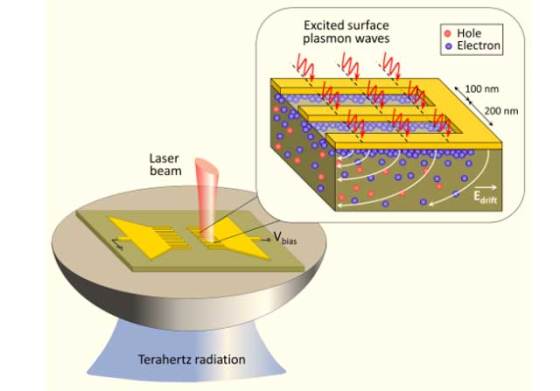New terahertz imaging system could replace x-ray imaging
 A group of researchers at the University of Michigan (U-M) have developed a laser-powered source and detector system which employs low-energy terahertz radiation with record high power and sensitivity. The breakthrough could enable doctors to see deep into tissues without the damaging effects of X-rays, or allow security guards to identify chemicals in a package without opening it.
A group of researchers at the University of Michigan (U-M) have developed a laser-powered source and detector system which employs low-energy terahertz radiation with record high power and sensitivity. The breakthrough could enable doctors to see deep into tissues without the damaging effects of X-rays, or allow security guards to identify chemicals in a package without opening it.
Laser-powered terahertz source and detector system developed by U-M researchers transmits 50 times more power and has 30 times more sensitivity than existing technologies. This offers 1,500 times more powerful systems for imaging and sensing applications.
“With our higher-sensitivity terahertz system, you could see deeper into tissues or sense small quantities of illegal drugs and explosives from a farther distance. That’s why it’s important,” said Mona Jarrahi, U-M assistant professor of electrical engineering and computer science and leader U-M’s Terahertz Electronics Laboratory.
U-M’s Terahertz Electronics Laboratory researchers accomplished this by funneling the laser light to specifically selected locations near the device’s electrode that feeds the antenna that transmits and receives the terahertz signal. This approach enables light to hitch a ride with free electrons on the surface of the metallic electrodes to form a class of surface waves called surface plasmon waves.
By coupling the beam of light with surface plasmon waves, the researchers created a funnel to carry light into nanoscale regions near device electrodes. The excited surface plasmon waves carry optical photons where they need to be much faster and much more efficiently.
“When you want to generate or detect terahertz radiation, you have to convert photons to electron hole pairs and then quickly drift them to the contact electrodes of the device. Any delay in this process will reduce the device efficiency”, said Jarrahi. “We designed a structure so that when photons land, most of them appear to be right next to the contact electrodes.”
Terahertz systems that are powered by lasers have been the most successful in the marketplace so far, thanks to the cost-effective, compact and high-power lasers available today. Other researchers are using different approaches to powering terahertz systems, though. According to Terahertz Electronics Laboratory researchers, the output power of the terahertz sources and the sensitivity of the terahertz detectors can be increased even further by designing optical funnels with tighter focusing capabilities.
For more information, read the paper published in Nature Communications: “Significant performance enhancement in photoconductive terahertz optoelectronics by incorporating plasmonic contact electrodes“.










Leave your response!